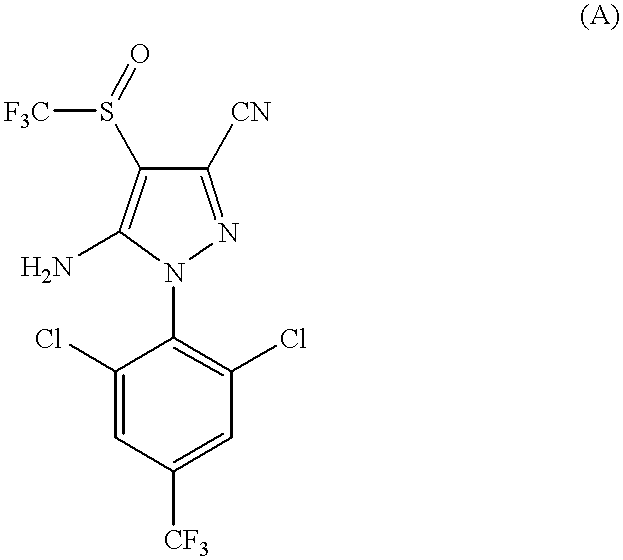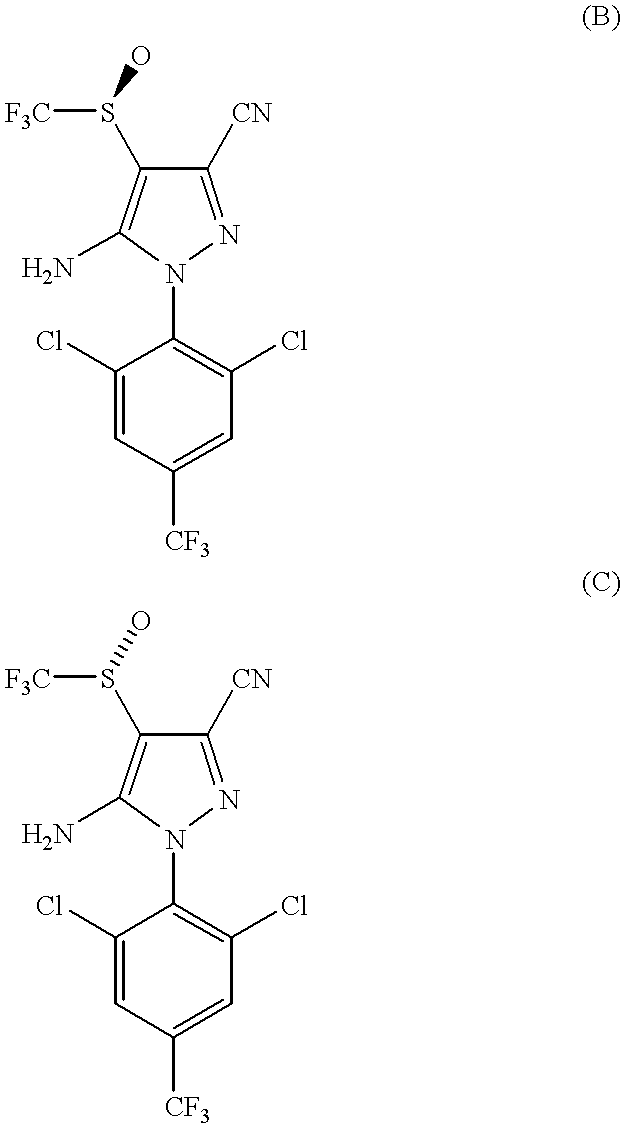Pesticidal composition comprising enantiomeric form of fipronil
a technology of enantiomeric form and composition, which is applied in the direction of biocide, antiparasitic agents, drug compositions, etc., can solve the problems of causing 100% mortality, 33% mortality, and dramatic increase in toxicity and emesis
- Summary
- Abstract
- Description
- Claims
- Application Information
AI Technical Summary
Benefits of technology
Problems solved by technology
Method used
Image
Examples
example 1
About 120 mg of fipronil, i.e., a 1:1 mixture by weight of (S)-5-amino-3-cyano-1-(2,6-dichloro-4-trifluoromethylphenyl)-4-trifluoromethylsulfinylpyrazole and (R)-5-amino-3-cyano-1-(2,6-dichloro-4-trifluoromethylphenyl)-4-trifluoromethylsulfinylpyrazole, were separated by HPLC (high-pressure liquid chromatography) using a stationary phase which was a Chiralcel.RTM. OD 21 mm.times.250 mm column, particle size about 20 microns (micrometers) and a mobile phase of isooctane: isopropanol 96:6 v / v ratio to provide 60 mg each of each enantiomer. The elution rate was about 6 mL per minute. Compound C, the (R) enantiomer, came off the column after about 20 minutes and Compound B, the (S) enantiomer, came off the column after about 40 minutes.
Solvent was removed from both samples and white powders were obtained.
The melting point of Compound B was about 204.degree. C. and the melting point of Compound C was about 201.degree. C.
The absolute configurations of the enantiomers as shown in formulas ...
example 2
Each of the compounds B and C of EXAMPLE 1 were formulated as a capsule in gelatin and orally administered to 10 mixed breed dogs at a rate of 20 mg of the compound per kg of body weight of the animal treated.
All animals were infested with cat fleas (Ctenocephalides felis) and brown dog ticks (Rhipicephalus sanguineus) 1 day prior to administration of the compounds. Counts of arthropods were made 1 day after treatment (DAT). Immediately after the determination of efficacy, all arthropods were removed from the dogs. The animals were re-infested with arthiropods at 8, 15, 22, and 30 days after treatment and efficacy determinations were made at 9, 16, 23, and 31 days after treatment.
The following efficacy results were obtained in per cent (%) mortality of the arthropods.
Within 5 hours after administration of the compounds, 50% of the dogs treated with the (S) enantiomer showed emesis whereas 90% of the dogs treated with the (R) enantiomer showed emesis.
example 3
The test of EXAMPLE 2 was repeated at the levels indicated and the following results were obtained:
At the 1 mg / kg treatment level, neither compound showed emesis in the animals.
At the 3 mg / kg treatment level, 20% of the animals treated with Compound C [the (R) enantiomer] showed emesis symptoms after 2 hours.
At the 10 mg / kg treatment level, 40% of the animals treated with Compound C [the (R) enantiomer] showed emesis symptoms after 1 hour. After 3 hours, 20% of the animals treated with the Compound C [the (R) enantiomer] showed emesis symptoms.
There were substantially no symptoms of emesis in animals treated with Compound B [the (S) enantiomer] at any rate.
PUM
| Property | Measurement | Unit |
|---|---|---|
| weight ratio | aaaaa | aaaaa |
| weight ratio | aaaaa | aaaaa |
| weight ratio | aaaaa | aaaaa |
Abstract
Description
Claims
Application Information
 Login to View More
Login to View More - R&D
- Intellectual Property
- Life Sciences
- Materials
- Tech Scout
- Unparalleled Data Quality
- Higher Quality Content
- 60% Fewer Hallucinations
Browse by: Latest US Patents, China's latest patents, Technical Efficacy Thesaurus, Application Domain, Technology Topic, Popular Technical Reports.
© 2025 PatSnap. All rights reserved.Legal|Privacy policy|Modern Slavery Act Transparency Statement|Sitemap|About US| Contact US: help@patsnap.com



